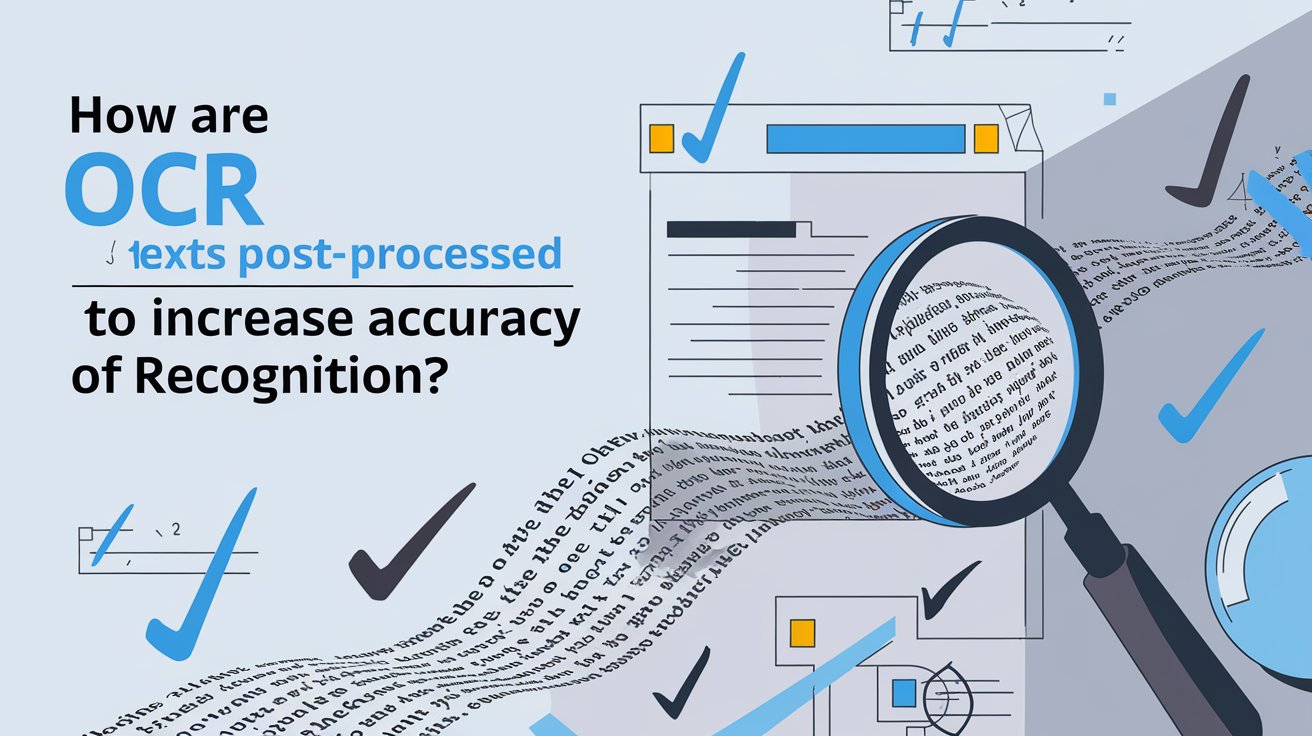Optical Character Recognition (OCR) has revolutionized the way we digitize text from physical documents, enabling the extraction of data from scanned images, PDFs, or even photographs. While OCR technology has come a long way in terms of speed and accuracy, it is still prone to errors, especially when dealing with low-quality scans, complex layouts, or non-standard fonts. To address these challenges, post-processing techniques are employed to enhance recognition accuracy and improve the overall quality of OCR-extracted text. This blog explores the various OCR post-processing strategies that significantly enhance text recognition accuracy.
What is OCR?
OCR, or Optical Character Recognition, is a technology that converts different types of documents, such as scanned paper documents, PDF files, or images captured by a digital camera, into editable and searchable data. While OCR systems have advanced in recent years, errors in recognition still occur, necessitating various post-processing steps to refine the results.
OCR errors typically arise from factors such as:
- Poor image quality or low resolution.
- Complex or non-standard fonts.
- Noise in the background.
- Poor lighting conditions or skewed text in images.
To mitigate these issues and enhance the accuracy of the extracted text, several post-processing methods are applied.
Why Post-Processing is Crucial in OCR?
Post-processing is essential to improve the reliability and usability of OCR-generated text. Raw OCR output can often be flawed, particularly when working with noisy, distorted, or multi-lingual text sources. This is why post-processing techniques are employed to refine and correct these errors, thereby boosting the overall accuracy and usefulness of the OCR system.
Post-processing techniques address common OCR errors such as:
- Incorrect recognition of characters, particularly those that look similar (e.g., “0” and “O” or “1” and “I”).
- Missing spaces between words or characters.
- Misinterpretation of special symbols, accents, or punctuation marks.
- Incorrect line breaks and formatting issues.
By applying these methods, the accuracy of OCR output can increase significantly, leading to better usability for applications like document archiving, data extraction, and digital text searchability.
Common OCR Post-Processing Techniques
1. Spell Checking and Language Models
One of the most effective post-processing techniques in OCR is the use of spell checking combined with language models. After the initial recognition process, the text is run through a spell checker that identifies and corrects words that were misinterpreted by the OCR engine. This is particularly useful when dealing with common spelling errors resulting from incorrect character recognition.
Spell-checking algorithms utilize dictionaries or predefined word lists to detect words that do not exist in the language. For example, if the OCR system misinterprets “house” as “h0use” (confusing the letter “O” with the number “0”), the spell checker can flag the error and suggest the correct word.
Language models, often trained using machine learning, can further enhance spell-checking by considering the context of surrounding words to make intelligent corrections. This approach goes beyond simple dictionary matching by accounting for the syntax and grammar of the language, reducing errors caused by homophones or context-sensitive words.
2. Character-Level Error Correction
OCR systems often confuse characters with similar shapes, such as “O” and “0” or “I” and “1.” Character-level error correction aims to rectify these common mistakes by focusing on individual characters rather than whole words. Machine learning models can be trained to detect frequent character-level mistakes and correct them automatically.
In cases where OCR systems process a specific set of characters repeatedly (e.g., serial numbers, license plates), training a character-specific model can greatly reduce recognition errors. Additionally, techniques such as heuristic analysis or the use of confusion matrices can help map common character errors and correct them accordingly.
3. Post-OCR Line and Paragraph Detection
Correct formatting, including line and paragraph breaks, plays a crucial role in document readability. During the OCR process, especially when dealing with multi-column layouts, skewed images, or non-standard text structures, the output may contain broken or merged lines.
Post-processing can apply advanced algorithms to detect line breaks, paragraphs, and proper document structure. Techniques such as Hough Transform can help detect lines and correct orientation, while machine learning models trained to understand document layout can restore paragraph formatting.
4. Levenshtein Distance for Word Correction
The Levenshtein distance algorithm is used to measure the difference between two strings, helping identify words that are close but not quite accurate. In post-processing, this method can help suggest the correct word when OCR introduces small errors. For example, if OCR misinterprets “quick” as “qucik,” the Levenshtein distance method can suggest “quick” as the correct alternative by calculating the number of single-character edits (insertions, deletions, substitutions) required to convert one word to another.
This technique is particularly useful when combined with a dictionary, allowing it to suggest only valid words, reducing false positives.
5. Pattern Recognition and Machine Learning
Machine learning has significantly advanced post-processing by enabling models to learn from past OCR errors. By training models on large datasets that include both correct text and common OCR mistakes, the system can recognize patterns in errors and apply intelligent corrections.
For instance, machine learning models can be trained to recognize patterns like specific fonts, languages, or text distortions. These models are particularly effective when processing documents with repetitive text structures, such as invoices, receipts, or legal documents. By identifying specific formatting patterns, the system can automatically apply the correct interpretation and formatting.
In addition to pattern recognition, models such as neural networks or recurrent neural networks (RNNs) are used to improve OCR accuracy by analyzing sequences of text and learning the most likely corrections based on context.
6. Contextual Corrections Using N-Grams
N-grams are a sequence of ‘n’ items (usually characters or words) that help in understanding the context of a word based on its neighboring words. For example, in the English language, “quick” is frequently followed by “brown,” whereas “qucik” is less likely to be found in any meaningful context.
Using n-grams, post-processing techniques can predict more likely word sequences, improving accuracy, especially in long texts. This method works well in conjunction with spell-checkers and language models to analyze context and correct errors based on the typical word patterns found in the language.
7. Dictionary-Based Corrections for Specific Use Cases
For OCR applications in niche fields such as legal, medical, or academic documents, using a specialized dictionary can be invaluable. These dictionaries contain industry-specific terms, phrases, and abbreviations that might not be present in general-purpose dictionaries. By applying a domain-specific dictionary during post-processing, OCR output can be fine-tuned to recognize and correct specialized terms that may otherwise be marked as errors.
8. Noise Reduction Techniques
Images used for OCR often suffer from noise—unwanted marks or distortions caused by poor scanning, uneven lighting, or image compression. Pre-OCR noise reduction techniques, such as binarization and contrast enhancement, improve the quality of the image before OCR processing. However, post-OCR techniques like denoising filters can also be used to refine the results.
By detecting artifacts or patterns of noise, machine learning models can be trained to correct these distortions, reducing the impact on recognition accuracy. Common noise reduction techniques include morphological operations, median filtering, and edge detection.
9. Dictionary Training for Non-English Text
Handling non-English text can present unique challenges for OCR systems, especially when dealing with languages that use different scripts, diacritical marks, or complex grammar structures. By incorporating multilingual dictionaries and specialized language models into post-processing, OCR systems can improve accuracy for non-English text.
For example, in languages like Arabic, Hindi, or Chinese, where characters may have different meanings depending on the context or diacritical marks, post-processing can detect errors based on grammar rules and correct the output using contextual hints from the text.
Conclusion: The Future of OCR Post-Processing
OCR technology has made significant strides in recent years, but post-processing remains a vital step in ensuring high accuracy in text recognition. Techniques such as spell-checking, character-level error correction, machine learning, and language models significantly improve the quality of OCR output, making it more reliable and usable for various applications.
As AI and machine learning continue to evolve, we can expect even more sophisticated post-processing techniques that further refine OCR results. By integrating these methods into OCR workflows, businesses and individuals can extract more accurate and usable data from physical documents, unlocking new possibilities for automation, data analysis, and digital transformation.
For industries where precision is paramount, such as healthcare, legal services, and finance, advanced OCR post-processing techniques will play an increasingly crucial role in transforming how we handle and interpret vast amounts of information.





